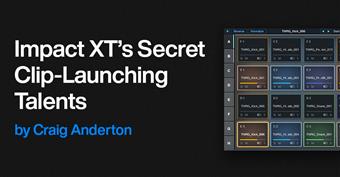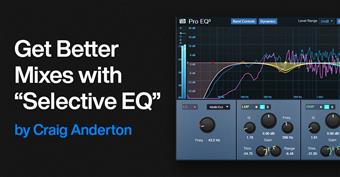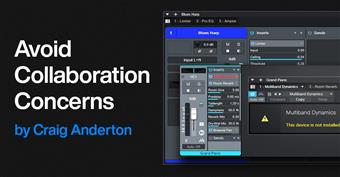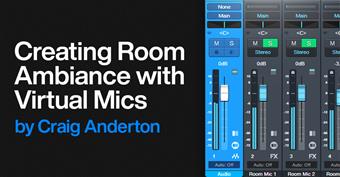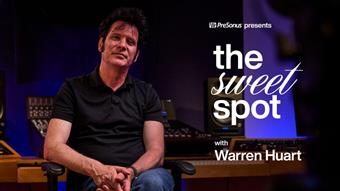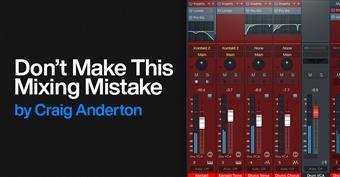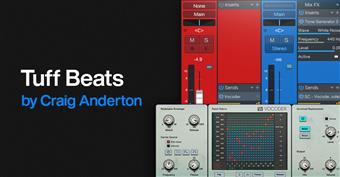
A VCA Channel has a fader, but it doesn't pass audio. Instead, the fader acts like a gain control for other channels, or groups of channels. In some ways, you can think of a VCA Channel as remote control for other channels. If you assign a VCA to control a channel, you can adjust the channel gain, without having to move the associated channel's fader. The VCA Channel fader does it for you.
Inserting a VCA channel works the same way as inserting any other kind of channel or bus. (However, there's a convenient shortcut for grouping, as described later.) To place a channel's gain under VCA control, choose the VCA Channel from the drop-down menu just below a channel's fader and let's get started with the applications.
APPLICATION #1: EASY AUTOMATION TRIM
Sometimes when mixing, you'll create detailed level automation where all the moves and changes are perfect. But as the mix develops, you may find you want to increase or decrease the overall level. There are several ways to do this, like inserting a Mixtool and adjusting the level independently of the automation, or using the automation's Trim control. However, a VCA control is sometimes easier, and besides, it can control several channels at once if desired, without having to feed them to a bus. The VCA fader can even offset automation for multiple tracks that are located within a Folder Track (Fig. 1)
Figure 1: Note how the label below each fader says VCA 1. This means each channel's gain is being controlled by the VCA 1 fader on the right. If all these tracks have their own automation, VCA 1 can bring the overall level up or down, without altering the automation shape, and without needing to send all their outputs to the same bus.
If the automation changes are exactly as desired, but the overall level needs to increase or decrease, offset the gain by adjusting the VCA Channel's fader. This can be simpler and faster than trying to raise or lower an entire automation curve using the automation Trim control. Furthermore, after making the appropriate adjustments, you can hide the VCA Channel to reduce mixer clutter, and show it only if future adjustments are necessary.
APPLICATION #2: NESTED GROUPING
One of the most common grouping applications involves drums-when you group a drum kit's individual drums, once you get the right balance, you can bring their collective levels up or down without upsetting the balance. Studio One offers multiple ways to group channels. The traditional option is to feed all the outputs you want to group to a bus, and vary the level with the bus fader. For quick changes, a more modern option is to select the channels you want to group, so that moving one fader moves all the faders.
But VCAs take this further, because VCA groups can be nested. This means groups can be subsets of other groups.
A classic example of why this is useful involves orchestral scoring. The first violins could be assigned to VCA group 1st Violins, the second violins to VCA group 2nd Violins, violas to VCA group Violas, and cellos and double basses to VCA group Cellos+Basses.
You could assign the 1st Violins and 2nd Violins VCA groups to a Violins Group, and then assign the Violins group, Violas group, and Cellos+Basses group to a Strings group. Now you can vary the level of the first violins, the second violins, both violin sections (with the Violins Group), the violas, the cellos and double basses, and/or the entire string section (Fig. 2). This kind of nested grouping is also useful with choirs, percussion ensembles, drum machines with multiple outputs, background singers, multitracked drum libraries, and more.
Figure 2: The 1st Violins and 2nd Violins have their own group, which are in turn controlled by the Violins group. Furthermore, the Violins, Violas, and Cellos+Basses groups are all controlled by the Strings group.
Although it may seem traditional grouping with buses would offer the same functionality, note that all the channel outputs would need to go through the same audio bus. Because VCA faders don't pass audio, any audio output assignments for the channels controlled by the VCA remain independent. You're busing gain, not audio outputs-that's significant.
If you create a group, then all the faders within that group remain independent. Although with Studio One you can temporarily exclude a fader from a group to adjust it, that's not necessary with VCA grouping-you can move a fader independently that's controlled by a VCA, and it will still be linked to the other members of a VCA group when you move the VCA fader.
Bottom line: The easiest way to work with large numbers of groups is with VCA faders.
APPLICATION #3: GROUPS AND SEND EFFECTS
A classic reason for using a VCA fader involves send effects. Suppose several channels (e.g., individual drums) go to a submix bus fader, and the channels also have post-fader Send controls going to an effect, such as reverb. With a conventional submix bus, as you pull down the bus fader, the faders for the individual tracks haven't changed-so the post-fader send from those tracks is still sending a signal to the reverb bus. Even with the bus fader down all the way, you'll still hear the reverb.
A VCA Channel solves this because it controls the gain of the individual channels. Less gain means less signal going into the channel's Send control, regardless of the channel fader's position. So with the VCA fader all the way down, there's no signal going to the reverb (Fig. 3)
Figure 3: The VCA Channel controls the amount of post-fader Send going to a reverb, because the VCA fader affects the gain regardless of fader position. If the drum channels went to a conventional bus, reducing the bus volume would have no effect on the post-fader Sends.
APPLICATION #4: BUS VS. VCA
There's a fine point of us
More from PreSonus
19/04/2024
By Craig Anderton
Impact XT can launch clips, which is great for songwriting (see the blog post Songwriting with Impact XT). But few people realize that Impact...
12/04/2024
By Craig Anderton
Good mixes often depend on carving out a unique sonic space for each instrument, so you can hear them clearly. Sometimes carving out that spa...
05/04/2024
By Craig Anderton
MIDI guitars are a niche product, because the learning curve can be daunting for some guitar players. However, I'm surprised how many pro...
29/03/2024
By Craig Anderton
As the universe of Studio One users grows, so do opportunities for collaboration. But your collaborator may not be using the same version of ...
22/03/2024
By Craig Anderton
Over three years ago, I wrote a blog post on how to make a drumcoder. Its design was somewhat like a vocoder-drum audio served as a modulat...
15/03/2024
By Craig Anderton
One of Atmos's coolest features is scalability. No matter how complex your Atmos project may be, you can render it as Binaural, 5.1, 5.1....
13/03/2024
Watch the Brooklyn Synthpop duo remix their song Blame in Studio One
Less than 24 hours after meeting each other, producer Luke Moellman and vocalist Jon San...
10/03/2024
By Craig Anderton
The impetus behind this design was wanting to add envelope flanging to amp sims like Ampire. But there's a problem: most amp sim outputs ...
01/03/2024
By Craig Anderton
Supplementing close-miking techniques with room mics gives acoustic sounds a life-like sense of space. Typically, this technique involves pla...
27/02/2024
Notion Mobile v3 took mobile music creation to the next level with support for iOS, Android, Windows, Fire OS and macOS. Now v3.3 adds many enhancements and fix...
26/02/2024
Logic's Grammy-nominated producer breaks down his Sweet Spot.
Before he found success as an avant-garde hip hop producer, 6ix was just 30 units shy of a de...
25/02/2024
The Grammy-nominated multi-Platinum producer breaks down his Sweet Spot.
From the studio with chart-topping artists like Aerosmith and The Fray, to empowering ...
23/02/2024
By Craig Anderton
Do you think of mixes in absolute terms, or relative terms? Knowing the difference, and when to apply which approach, can make a huge differe...
16/02/2024
By Craig Anderton
Calling all beats/hip-hop/EDM/hard rock fans: This novel effects starts with drums modulating the Vocoder's white noise carrier, and take...
09/02/2024
This tip is about working with stereo, NOT about Dolby Atmos or surround-but we're going to steal some of what Atmos does to reinvent stereo panning. Stud...
07/02/2024
The GRAMMY-winning recording and mix engineer shows us how he uses Studio One to create an artful immersive mix.
Jeff Ellis is a force to be reckoned with. The...
02/02/2024
Presence's sound library includes a fine acoustic 12-string guitar, but not an electric one. So, perhaps it's not surprising that one of the more popula...
26/01/2024
At first, this might not seem too exciting. But follow the directions below, and try comping using this method-I don't think you'll be disappointed. Thi...
19/01/2024
You know the feeling: You're tracking or doing an overdub with a virtual instrument or amp sim, but you're frustrated by the excessive latency inherent ...
12/01/2024
Recording audio using more than one feed from the same source may create phase issues. For example, when miking a bass amp and taking a DI (dry) input, the DI&#...
05/01/2024
If you haven't experimented yet with mid-side stereo miking, you'll be in for a treat when you do. Here's why:
Record background singers with gorge...
29/12/2023
This complements the tip Better Ducking for Voiceovers and Podcasts and the tip Why I Don't Use Compression Anymore. It applies the concept of voiceover duc...
22/12/2023
Engineers sometimes advocate using high-pass filters to clean up the low end and tighten the sound. Others believe that because of issues inherent in highpass...
20/12/2023
The GRAMMY-nominated artist, producer, and songwriter shows us how he uses Studio One to cook a musical idea from scratch.
Josh Cumbee is a triple threat: The ...
15/12/2023
This wasn't a conscious decision, or something I planned. But when I looked through my last few songs while seeking candidates for a book's screenshots,...
08/12/2023
First, a follow-up: In the October 13 tip about creating Track Presets for parallel processing, I mentioned that Track Presets can't include buses, which is...
01/12/2023
Vocoder's aren't normal effects. For example, Arturia's Vocoder V is an effect/instrument hybrid, because it's an audio effect that includes a...
24/11/2023
For over a decade, stereo and mono vinyl records co-existed before the transition to stereo was complete. During that time, many records were released in both m...
17/11/2023
Strings can enhance almost any genre of music-and with a little more effort, you can do string arrangements that go beyond simply adding a string pad preset. So...
10/11/2023
Since Dynamic EQ was introduced in version 5, I've used it to replace and improve some techniques I used to do with static EQ. For example, I'm a fan of...
03/11/2023
Gregor Beyerle recently posted a video called Producer vs. Engineer-What's the Difference?, which had quite a few comments. It seems most people feel that f...
27/10/2023
Sending too many low frequencies through reverb gives a bloated, muddy sound. This is one reason why you'll rarely see a send from a bass track going into r...
20/10/2023
While trying to do something else with Melodyne, I stumbled on this way to add depth or tightness to drum sounds-quickly and easily. Here's the sound of an ...
13/10/2023
Parallel processing splits a signal into two or more parallel channels. Bi-amping is a common example of parallel processing:
One channel processes low frequen...
06/10/2023
Everyone talks about the importance of Dolby Atmos for post-production, but the implications go further than that. Atmos really does change how you create and ...
29/09/2023
You don't need a massive surround system with speakers wired all over your studio to create immersive audio. Whether you want surround or Dolby Atmos mixes...
22/09/2023
By Craig Anderton
Background music or environmental sounds are usually an essential part of commercials, movies, presentations, podcasts, and more. When doing ...
15/09/2023
The post Mixing la Studio One had a great response, so here's another tip that relates more to making better music than making better-sounding music. We&#...
08/09/2023
This FX Chain's inspiration is the Tilt filter circuit created by Tonelux designer Paul Wolff. First used in the Tonelux MP1A mic preamp, the Tilt filter h...
01/09/2023
But first, some breaking news: Version 1.5 of The Huge Book of Studio One Tips and Tricks is now available from the PreSonus shop. Like previous versions, it�...
25/08/2023
Studio One 6.2 reworked Layer and Take handling, and some of the new functionality is exceptionally useful. For example, suppose you want to record comp vocals ...
18/08/2023
We haven't done a boutique digital effect for Studio One Professional in a while, so let's use a plugin in a totally wrong way-yet end up with somethi...
11/08/2023
MIDI drum loops have a bad rap, because some musicians consider them metronomic and boring. But they don't have to be. Subtly leading or lagging the beat at...
04/08/2023
Ask 100 recording engineers about their approach to mixing, and you'll hear 100 different answers. Here's mine, and how this approach relates to Studio ...
28/07/2023
FL Studio is a cool program. Yet when some users see me working with Studio One's features like comping tools, harmonic editing, the lyrics track, Mix FX, M...
21/07/2023
Bass has a tough gig. Speakers have a hard time reproducing such low frequencies. Also, the ear is less sensitive to low (and high) frequencies compared to midr...
18/07/2023
Notion Mobile v3 took mobile music creation to the next level with support for iOS, Android, Windows and macOS. Now v3.2 adds many enhancements and fixes, as we...
14/07/2023
First, an announcement: If you own the eBook How to Record and Mix Great Vocals in Studio One, you can download the 2.1 update for free from your PreSonus acc...
07/07/2023
Let's transform your acoustic piano instrument sounds-with effects that showcase the power of Multiband Dynamics. Choose from two download links at the end ...
24/06/2023
Acoustic drum loops freeze-dry a drummer's playing-so, what you hear is what you get. What you get. What you get. What you get. What you get. What you get.
...
 A VCA Channel has a fader, but it doesn't pass audio. Instead, the fader acts like a gain control for other channels, or groups of channels. In some ways, you can think of a VCA Channel as remote control for other channels. If you assign a VCA to control a channel, you can adjust the channel gain, without having to move the associated channel's fader. The VCA Channel fader does it for you.
A VCA Channel has a fader, but it doesn't pass audio. Instead, the fader acts like a gain control for other channels, or groups of channels. In some ways, you can think of a VCA Channel as remote control for other channels. If you assign a VCA to control a channel, you can adjust the channel gain, without having to move the associated channel's fader. The VCA Channel fader does it for you.













